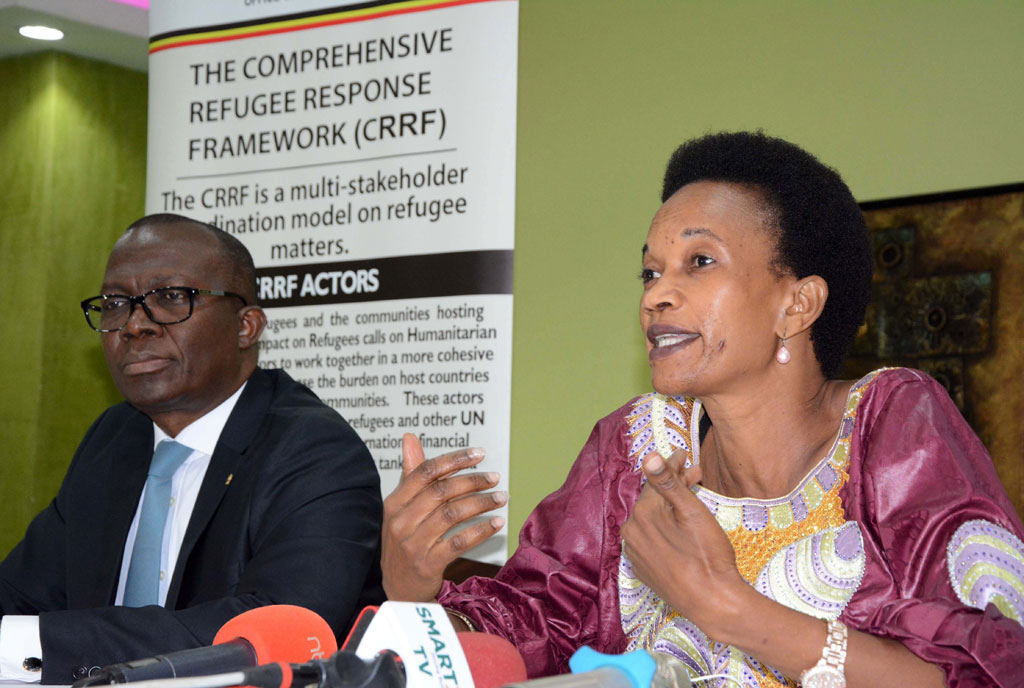Govt to close transit refugee camp

The United Nations High Commissioner for Refugees Uganda representative, Mr Matthew Crentsil (left), and the Minister for State for Relief, Disaster Preparedness and Refugees, Ms Esther Anyakun, during the Comprehensive Refugee Response framework meeting in Kampala, September 28, 2022. PHOTO/SYLIVIA KATUSHABE
What you need to know:
- The government encourages refugees to be resettled in order to benefit from government programmes.
The minister of State for Relief, Disaster Preparedness and Refugees, Ms Esther Anyakun, has revealed government plans to close the Nyakabande transit refugee camp in Kisoro District.
Ms Anyakun said the camp hosts about 100,000 refugees from DR Congo who have camped there since March and it has since become expensive to provide for them.
“Leave alone the issues of resources, it is quite very expensive, taking care of thousands of people, as we talk now, they accumulated to 100,000 people in one place,” Ms Anyakun said during the Comprehensive Refugee Response framework meeting in Kampala yesterday.
She added: “Feeding them, medication and giving basic needs to those people is very costly for our partners to continue doing this with the current crisis that we know is happening in the world that was affected by Covid-19 and also in Ukraine.”
Uganda has been having an influx of refugees from DRC through Bunagana border post into Kisoro District following the renewed fighting between M23 rebels and the Congolese government soldiers.
Ms Anyakun said the World Food Programme spends about eight metric tonnes of food daily.
“Kisoro District has been one of our transit centres just like you see in Kasese, Bundibugyo, Ntoroko and others, we don’t expect refugees to stay there for a longer period. Because of this influx, we even had to leave the space in the transit centre and created another bigger space for the asylum seekers and since March 28, we have been having all these refugees in one place,” Ms Anyakun said.
She said although government has worked hard to ensure that refugees in non-gazetted areas vacate and those in gazetted areas be taken to settlement areas such as Nakivale and Kyaka11, some have deliberately refused to leave.
Ms Anyakun said the government has given them up to October 31 to either go to the resettlement areas or go back to their countries.
She said one becomes an asylum seeker or refugee when they leave transit centres and are resettled.
The United Nations High Commissioner for Refugees Uganda representative, Mr Matthew Crentsil, said they support government’s decision to take the refugees to settlement areas, adding that it gives them an advantage.
He said settlement camps have better economic opportunities, freedom of movement and more dignified lives.
“One may ask themselves, in such crowded areas like Nyakabande transit camp, what livelihood activities can refugees undertake? What are the opportunities for the children to attend school?” Mr Crentsil asked.
He said they are spending half a million dollars to maintain the centre, which takes away the resources that would otherwise be used to develop the settlements.
Mr Crentsil said they were working closely with government to sensitise the refugees about the advantage of settlement areas.
The Minister of State for Local Government, Ms Victoria Rusoke, said there is need to add value to the refugees.
“If we skill the women and youth they will have earnings. We can also supply them with seedlings and seeds for them to produce food rather than waiting for food distribution which may even not come on time,” Ms Rusoke said.
She said they should be integrated and the host communities in government programmes such as Parish Development Model to sustain themselves.




